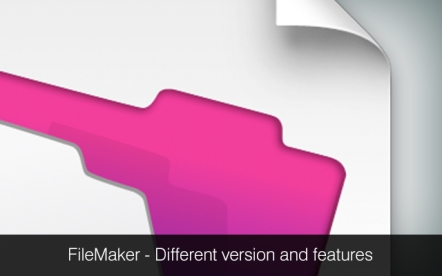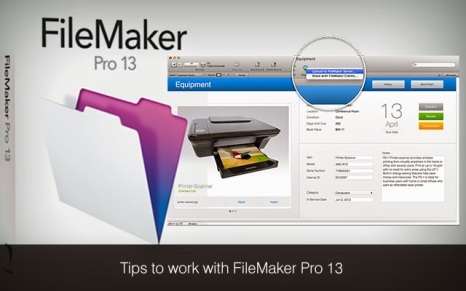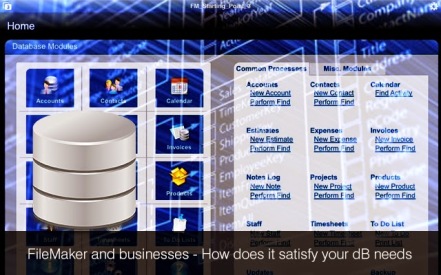At present, FileMaker is one of the most widely used cross-platform relational database applications in the market. As it is designed by integrating a database engine with a GUI interface, FileMaker makes it easier for developers to create custom applications by dragging different elements into the form, screen or layout. But FileMaker was originally launched as a DOS-based application called Nutshell in early 1980s. The product was subsequently purchased by Claris, and renamed as FileMaker II. Thus, the versions of FileMaker can be divided into pre-FileMaker 6 and post-FileMaker 6.

At present, FileMaker is one of the most widely used cross-platform relational database applications in the market. As it is designed by integrating a database engine with a GUI interface, FileMaker makes it easier for developers to create custom applications by dragging different elements into the form, screen or layout. But FileMaker was originally launched as a DOS-based application called Nutshell in early 1980s. The product was subsequently purchased by Claris, and renamed as FileMaker II. Thus, the versions of FileMaker can be divided into pre-FileMaker 6 and post-FileMaker 6.
Evolution of FileMaker as a Cross-Platform Relational Database Application
Version 4.0
In 1997, FileMaker 4.0 was released with a plug-in architecture. The version was designed just like Adobe Photoshop. The plug-in architecture enables developers to add custom features to the application. At the same time, the users also have option to use FileMaker as a web server using a bundled plug-in called Web Companion. The version 4.0 also allowed programmers to perform several file operations, along with sharing FileMaker files over the web or intranet.
Version 7
In 2004, FileMaker 7 was released with a new file format which supported file size up to 8 terabytes. The version also allowed individual fields to hold binary data up to 4 gigabytes or 2 gigabytes of 2-byte Unicode text per record. The enhanced relational model now enabled programmers to offer multiple tables for file. Also, the users have option to manipulate the related tables through a graphical relationship editor.
Version 8
The FileMaker 8 product family was introduced in 2005. The FileMaker 8 product family enabled developers to avail a number of advanced features like script variables, custom menus, tabbed interface, tooltips and enhanced debugging. Also, the users have option to copy and paste scripts, script steps, and whole tables and field definitions. The new features made it easier for developers to create custom database applications according to client’s specific requirements.
Version 9
FileMaker 9 was introduced in 2007 with a number of new features including conditional formatting, fluid layout auto-resizing, external SQL link, and hyperlinked pointers into databases. The Quick Start screens provided by FileMaker 9 further made it easier for users to access and update the database application in a quicker and more efficient way. The version also allowed uses to share images, documents, spreadsheets and other content of a field through emails.
Version 10
FileMaker 10 was released in 2009 with a completely revamped user interface. It came with a status bar that displayed some of the commonly used tools at the fingertip. Also, the version 10 came with a number of new features like script triggers, saved finds and dynamic report. It further allowed users to send emails directly through the SMTP server without using any additional email client.
Version 11 and 12
FileMaker 11 was released in 2010, whereas FileMaker 12 was introduced in 2012. The version 12 streamlined some of the major features introduced with FileMaker 11. FileMaker 11 allowed users to quickly create reports in a spreadsheet-like format, and make the reports appealing using a variety of charts. It further enabled users to search for information just like initiating web searches. FileMaker 12 made it easier for developers to accomplish precise design by using a variety of design layout tools. The version also included a variety of scripts, themes and design tools for iOS development. These versions also came with several new themes and database templates. FileMaker 12 further made it easier for programmers to create iOS databases.
Version 13
The most recent version of FileMaker was released in 2013. FileMaker 13 supports several web and mobile methods of data access. It further allows developers to create custom themes using colors, font, text size and similar attributes. The programmers can further create new fields, and drag and drop multiple fields directly into the layout. They can further reuse the custom themes across different projects. The version further optimizes the security of data using AES 256-bit encryption.
At present, users have option to choose from four distinct versions of FileMaker 13 according to their specific needs. Each user can chose FileMaker Pro 13, FileMaker Pro Advanced 13, FileMaker Server 13 or FileMaker Go 13. The features of each version of FileMaker 13 differ, along with the targeted users. So it is important for the user to compare the features of each version of FileMaker 13 according to his requirements.
We provide FileMaker development services. If you would like to hire FileMaker developers for your development needs, please contact Mindfire Solutions.
Evolution of FileMaker as a Cross-Platform Relational Database Application
Version 4.0
In 1997, FileMaker 4.0 was released with a plug-in architecture. The version was designed just like Adobe Photoshop. The plug-in architecture enables developers to add custom features to the application. At the same time, the users also have option to use FileMaker as a web server using a bundled plug-in called Web Companion. The version 4.0 also allowed programmers to perform several file operations, along with sharing FileMaker files over the web or intranet.
Version 7
In 2004, FileMaker 7 was released with a new file format which supported file size up to 8 terabytes. The version also allowed individual fields to hold binary data up to 4 gigabytes or 2 gigabytes of 2-byte Unicode text per record. The enhanced relational model now enabled programmers to offer multiple tables for file. Also, the users have option to manipulate the related tables through a graphical relationship editor.
Version 8
The FileMaker 8 product family was introduced in 2005. The FileMaker 8 product family enabled developers to avail a number of advanced features like script variables, custom menus, tabbed interface, tooltips and enhanced debugging. Also, the users have option to copy and paste scripts, script steps, and whole tables and field definitions. The new features made it easier for developers to create custom database applications according to client’s specific requirements.
Version 9
FileMaker 9 was introduced in 2007 with a number of new features including conditional formatting, fluid layout auto-resizing, external SQL link, and hyperlinked pointers into databases. The Quick Start screens provided by FileMaker 9 further made it easier for users to access and update the database application in a quicker and more efficient way. The version also allowed uses to share images, documents, spreadsheets and other content of a field through emails.
Version 10
FileMaker 10 was released in 2009 with a completely revamped user interface. It came with a status bar that displayed some of the commonly used tools at the fingertip. Also, the version 10 came with a number of new features like script triggers, saved finds and dynamic report. It further allowed users to send emails directly through the SMTP server without using any additional email client.
Version 11 and 12
FileMaker 11 was released in 2010, whereas FileMaker 12 was introduced in 2012. The version 12 streamlined some of the major features introduced with FileMaker 11. FileMaker 11 allowed users to quickly create reports in a spreadsheet-like format, and make the reports appealing using a variety of charts. It further enabled users to search for information just like initiating web searches. FileMaker 12 made it easier for developers to accomplish precise design by using a variety of design layout tools. The version also included a variety of scripts, themes and design tools for iOS development. These versions also came with several new themes and database templates. FileMaker 12 further made it easier for programmers to create iOS databases.
Version 13
The most recent version of FileMaker was released in 2013. FileMaker 13 supports several web and mobile methods of data access. It further allows developers to create custom themes using colors, font, text size and similar attributes. The programmers can further create new fields, and drag and drop multiple fields directly into the layout. They can further reuse the custom themes across different projects. The version further optimizes the security of data using AES 256-bit encryption.
At present, users have option to choose from four distinct versions of FileMaker 13 according to their specific needs. Each user can chose FileMaker Pro 13, FileMaker Pro Advanced 13, FileMaker Server 13 or FileMaker Go 13. The features of each version of FileMaker 13 differ, along with the targeted users. So it is important for the user to compare the features of each version of FileMaker 13 according to his requirements.
We provide FileMaker development services. If you would like to hire FileMaker developers for your development needs, please contact Mindfire Solutions.









